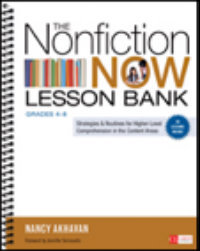Nonfiction Lessons to Use Now
The Nonfiction NOW Lesson Bank (Grades 4-8): Strategies and Routines for Higher-Level Comprehension in the Content Areas
By Nancy Akhavan
(Corwin Literacy, 2014 – Learn more)

The reading process is a complex cognitive process. In my 6th grade classes, students often look at me in confusion, struggling to understand what they are reading. I often remind them of the various thought processes needed to comprehend any given text. The Nonfiction NOW Lesson Bank by Nancy Akhavan addresses this confusion and sorts through the jargon to develop a clear and precise “Lesson Bank” creating a deeper understanding of nonfiction reading.
After reading the foreword by Jennifer Serravallo, I said a silent “amen.” She wrote, “You can tell Nancy is a classroom teacher first. Sure, she’s also been a professor and a principal and staff developer and authored many professional books. But when you read this resource you now hold in your hands, what shines through is this: Nancy is a teacher.” It is apparent in each chapter of the book that Nancy Akhavan understands how busy teachers are because she has written a practical guide that can be implemented immediately.
Tools to guide students in the process of critical reading

- Part I, The ‘NOW’ Factor of Nonfiction Reading, explores the kinds of informational text available today, and the latest thinking on the comprehension process involved in reading them.
- Part II, The Daily Duo, lays out routines for reading and writing that expand students’ reading comprehension, of the information they are reading about and confidence with nonfiction.
- Part III, The Lessons and Texts, gives exemplary lessons and authentic short nonfiction texts to use with students – right away.” Nancy Akhavan
The author states that students need to “wrestle with words, the meaning and the problems or paradoxes that the text might present.” Wrestle is the perfect verb when students are trying to dig deeper into the text. Reading goes beyond just understanding words, and that is why close and critical reading is essential for deeper meaning. Chapter two centers on modeling close reading. Akhaven points out that before modeling close reading, students need to determine when is close reading an appropriate kind of reading.
Close reading is utilized to do the following:
– Determine deep meaning of text
– Analyze author’s meaning and purpose in relation to text structure
– Tackle texts above their current reading level, but gain insight into a subject area, an author’s thinking or a historical, political context connected to a text.
A close look at modeling
Nancy Akhavan breaks down the step of modeling into four different readings that include what does the text say, how does the text say it, what does the text mean and what does the text mean to me. I appreciate the emphasis on rereading text for different purposes as well as the fundamental need to model. One sample lesson in the book is simple, but is the perfect example of close reading. The lesson models how to read a photo of a boy holding his pet dog. Four different steps demonstrate the various levels of viewing an image to dig deeper into the meaning. This is such a simple example, but effective in demonstrating the process of close reading to students.
The Nonfiction NOW Lesson Bank is a complete step-by-step collection of lessons offering strategies and routines essential for pushing students to higher-level comprehension in content areas. Each of the 50 lessons is clearly outlined along with ready-to-use texts, reproducible forms and graphic organizers. The resources alone make this book a bargain. Add to the resources the teaching strategies connected to the CCSS, and you have a powerful combination. Nancy Akhavan has written a professional book that will an integral part of my lesson planning as well as a gem to share with others.
Sandy Wisneski is lead teacher at Catalyst Charter Middle School which opened in the fall of 2013. She is the district webmaster, tech mentor, and yearbook advisory as well as new teacher mentor. Over the past 37 years she has become certified as a Flat Classroom Teacher and obtained her masters in reading. She enjoys challenging students to “take ownership” for their learning and to be effective digital citizens in the world.

































